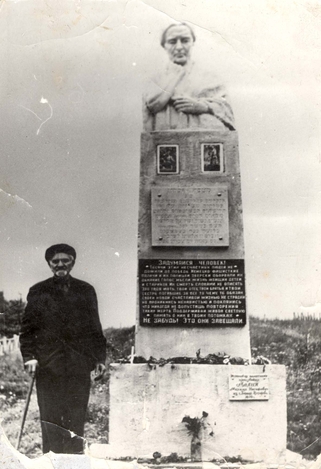Holocaust II
|
This page contains links to a variety of memoirs and historical records pertaining to the Holocaust.
Yad Vashem, in Israel, is a primary source for these links. Another productive source is a website
called
AHEYM (The Archives of Historical and Ethnographic Yiddish Memories), sponsored by Indiana University at Bloomington,
that contains brief memoirs of people who lived through the Holocaust.
Lev Kolodenko, born in Tulchyn in 1925, worked in Tulchyn's shoe factory until 1941 when he was drafted into the army,
rising to the rank of sergeant.
Here is his story:
Lev Kolodenko.
|
The Berdichev Revival website contains a discussion of the film Fading Traces, directed by Walo Deuber, which
contains appearances of three
Tulchyn Holocaust survivors and witnesses: Rosa Roitman, her sister Esther Bartik, and her brother-in-law Michail Bartik.
One must scroll through the webpage Fading Traces
to locate the story of this family.
|
|
The German invasion of the Soviet Union was soon followed by the the Nazis' entry into Vinnitsa Oblast (Podolia
Province was renamed Vinnitsa
during the 1930's). Rather than retaining the province under their direct control, the Germans turned most of it over to Romania,
renaming it Transnistria – the region sandwiched between the Bug and Dniester Rivers, and extending southward
to the Black Sea. The Germans retained the northwestern portion of Vinnitsa.
Once ensconced in Russian lands,
the Nazis' followed their standard routine, murdering Jews wherever they found them; this "cleansing" continued
until the end of 1942 – about eighteen months of continuously dedicated effort. During this time, Romanian Jews
were herded into the newly formed Transnistria Province; about one-hundred-twenty-thousand people. Once there,
|
the Jews were
forced into the ghettos established in the region's towns, which included Tulchin ghetto.
Many of these Jews were used
as slave labor
in the Pechera Labor Camp, thirteen miles northwest of Tulchin. By the time Soviet troops kicked the Germans out, in 1944,
there remained about half the number of Jews that were in the area two years earlier; of these, fifteen-thousand people were
native to what had been Vinnitsa Province. Details of these events can be found in
The Holocaust in Vinnitsa Oblast by
Faina A. Vinokurova, Vice-Director, State Archive of Vinnitsa Oblast.
|
|
Einsatzkommandos (Operational Squads; in fact, killing squads) 10B and 11B of
Einsatzgruppe D,
initially under the command of Otto Ohlendorf, later commmanded by Walter Bierkamp,
were assigned to the Transnistria region in July 1941.
The commanders of the Einsatzkommandos sent progress reports back to headquarters.
Many of these reports survived The War and are available to the public. The following link contains portions of these reports
that were used in the trial of the commander of Einsatzgruppen D:
Military Tribunal II.
|
Otto Ohlendorf, along with commanders of the other Einsatzgruppen, was tried for his crimes in a six month
trial extending from
29 September 1947 to 10 April 1948. Ohlendorf was found guilty and was sentenced to death. He was hanged on 7 June 1951.
See Einsatzgruppen, published by the USHMM,
and also see The Einsatzgrüppen
for more information on Einsatzgruppen.
|
|
After World War II monuments were placed at the site of the mass murders to commemorate the
Jewish victims of Nazi barbarism. Several of the monuments do not mention that the victims were Jewish.
Yad Vashem's Photo Archive has photographs, augmented with brief histories, of the Tulchin monuments.
Here are two of these photographs; a photo of the
|
monument to the Mass Murder site can be found on the introduction page
to the People Stories section of this Kehilalink.
Yad Vashem provides the locations of the
Vinnitsa Region killing sites, though there is no mention of Tulchin.
|
|

Road to the mass murder site
( Yad Vashem & Boris Elenikov)
|

Labor Camp
( Yad Vashem & Fronik Barko)
|
|
|